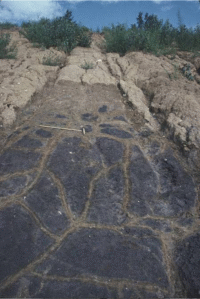On-Demand Webinars
TAKING THE MYSTERY OUT OF COMPLEX GLACIAL SEQUENCES AT ENVIRONMENTAL AND GEOTECHNICAL SITES
Part II: Understanding the Effects of Post-Depositional Weathering: Development of Weathering Zones and Secondary Jointing
Surficial weathering alters the geotechnical and hydrogeologic properties of glacial sediments. South of the Canadian Shield, where glacial deposits are derived from Paleozoic and younger sedimentary bedrock, distinctive weathering patterns and weathering zones develop from the surface downward.
Surficial soils develop from the land surface downward and are commonly 0.5 to 2 m (1.5 to 6 feet) thick. Alteration is so great that these surficial soils have a pervasive secondary soil structure that largely obliterates any primary sedimentary structure.
Beneath the surficial soils, weathering continues but is not as intensive, and a sequence of "weathering zones" develop. These zones are defined on the basis of:
- Color-related oxidation state
- Carbonate status (leached or unleached)
- Presence of absence of jointing
The sequence and depth of these weathering zones indicate the nature and extent of the subsurface alteration that these deposits have undergone.
Weathering zones can be quickly and readily described using simple letter abbreviations, and are extremely important in depicting the weathering changes that have taken place to different units in the glacial succession.

Accompanying weathering is the development of secondary jointing: fractures that affect infiltration and sediment strength. Examination of fracture geometry indicates that they develop from desiccation. Although there is still much research to be completed, the desiccation process significantly affects the hydraulic conductivity of fine-grained glacial deposits.
What does taking the mystery out of weathered glacial deposits require? An understanding of surficial soils, weathering zones, and secondary joint development. This webinar, Part II, provides techniques for identifying and understanding weathering zones and the occurrence of secondary jointing. Join us for this webinar and learn how to take the mystery out of the complex glacial sequences underlying your environmental and geotechnical sites.
This webinar is the second part in a Three Part Series in characterizing complex glacial sedimentary successions. Register for all three and receive a special reduced rate along with complimentary field tools by Midwest GeoSciences Group.
Instructor Bio
Tim Kemmis, PhD, PG
 Tim Kemmis received his bachelor's degree in agricultural soil science from the University of Illinois and his master's degree in glacial geology while working as a graduate assistant at the Illinois State Geological Survey. Tim Kemmis received his bachelor's degree in agricultural soil science from the University of Illinois and his master's degree in glacial geology while working as a graduate assistant at the Illinois State Geological Survey.
He worked 14 years for the Iowa Geological Survey, during which he received his Ph.D., and where he:
- Carried out glacial sedimentologic investigations
- Remapped the Des Moines Glacial lobe
- Established the formal glacial stratigraphy for the lobe based on depositional environments
- Discovered a new type of hummocky glacial topography
- Determined the geometry and origin of jointing in glacial tills
- Developed a lithofacies code to decipher the history of glacial outwash and alluvial sequences
Tim was a co-founder of Midwest GeoSciences Group and has successfully taught many courses and webinars dedicated to improving boring logs and helping geologists think on their feet.
| Fee: |
299.00 USD Per Webinar
|
| Materials and Downloads: |
Session Slides (PDF)
Additional MaterialsRecord of Attendance Form (PDF)
|
Number of
Participants: |
AS OF JUNE 1, 2020, WEBINARS ARE PRICED FOR INDIVIDUALS WORKING ALONE. Pricing is discounted for individual registrations for people working alone.
|
Continuing
Education
Certificates: |
$14.95 each. Official CEU certificates are available as an option. After successful completion of this webinar, a link will be provided to order a certificate.
|
| Access: |
On-demand, anytime 24/7. |
| Discounts: |
Buy 3 on-demand webinars, and get 3 on-demand webinars for free!
|
| Duration: |
90 minutes |
| PDH Earned: |
1.5 hours |
| MA LSP: |
1.5 hours (MA LSP No. 1417-N) |
| CT LEP: |
1.5 hours (part of CT LEP-308E) |
| |
|
| Instructor(s): |
Tim Kemmis, PhD, PG, AECOM Environment, Sheboygan, Wisconsin |
|
Become A Member
It's Free, It's Easy and as a
Member you'll enjoy...
- Exclusive Videos
- Special Pricing
- And Much More
|
|
Join
|
Learn More
|
Association of Environmental
& Engineering Geologists
|